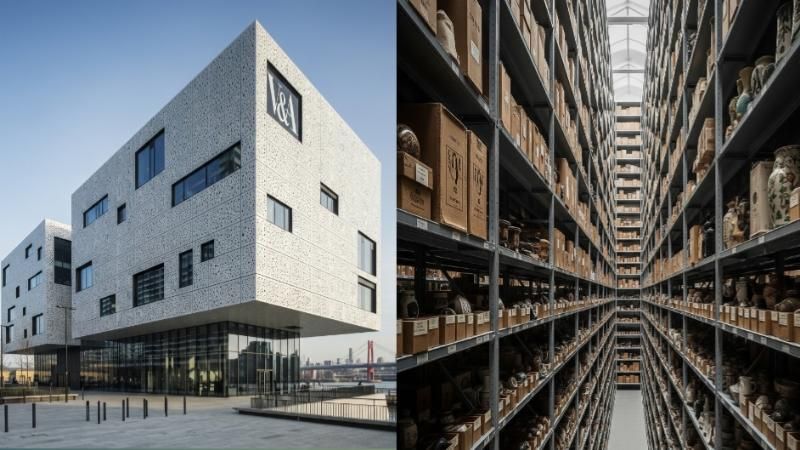Defying traditional museum conventions, London's renowned Victoria and Albert Museum (V&A) has unveiled a groundbreaking approach to showcasing its vast collection with the opening of V&A East Storehouse. Moving beyond the "iceberg" model where most artifacts remain hidden in storage, this innovative new facility throws open its doors, inviting visitors not just to observe, but often to directly interact with, an astonishing array of objects spanning five millennia of human creativity.
Located in East London, the colossal 16,000-square-meter (170,000-square-foot) Storehouse, equivalent in size to over 30 basketball courts, houses an incredible 250,000 objects, 350,000 books, and 1,000 archives. Stepping into its vast, three-story collections hall evokes a sense of exploration, akin to a treasure hunt through an immense, meticulously organized warehouse, but with priceless historical and artistic artifacts at every turn.
As Britain's national museum of design, performance, and applied arts, the V&A boasts an unparalleled collection. The Storehouse provides an unprecedented glimpse into this wealth, with aisle after aisle of open shelves displaying everything from ancient Egyptian footwear and Roman pottery to intricate ancient Indian sculptures, formidable Japanese armor, iconic Modernist furniture, a classic Piaggio scooter, and even a vibrant, brightly painted garbage can from the Glastonbury Festival.
"It's 5,000 years of creativity," remarked Kate Parsons, the museum's director of collection care and access. She highlighted the monumental task of relocating the collection, which involved 379 truckloads over more than a year, from the museum's previous storage facility in west London to its new home.
The most revolutionary aspect of the V&A East Storehouse is its "Order an Object" service. This pioneering initiative allows anyone to book a personalized, one-on-one appointment to view virtually any item from the collection. From a Vivienne Westwood mohair sweater to a delicate Japanese netsuke figurine, the vast majority of these items can even be handled by visitors, with the exception of hazardous materials like arsenic-laden Victorian wallpaper.
Parsons described the "Order an Object" service as offering "a behind-the-scenes, very personal, close interaction" with the collection. Among the most sought-after items so far is a stunning 1954 pink silk taffeta Balenciaga evening gown. Nearby study rooms have already hosted bespoke viewings of pieces like a Bob Mackie-designed military tunic worn by Elton John on his 1981 world tour, and two exquisite silk kimonos laid out for a recent visitor.
Since its opening at the end of May, the public response has been "phenomenal," according to Parsons. Visitors have ranged from individuals seeking inspiration for their weddings to dedicated art students, and even someone who last week meticulously measured the thread count of an 1850 dress. Parsons also noted that strangers, brought together by their shared interest in different objects, frequently strike up engaging conversations. A dedicated viewing gallery also allows the public to observe museum staff at work.
This increased emphasis on accessibility and transparency comes at a time when UK museums are facing intensified scrutiny regarding the provenance of their collections. They are under growing pressure to address and potentially repatriate objects acquired under sometimes contentious circumstances during the era of the British Empire.
Senior curator Georgia Haseldine underscored the V&A's commitment to a policy of transparency. "We can talk very openly about where things have come from, how they ended up in the V&A’s collection, and also make sure that researchers, as well as local people and people visiting from all around the world, have free and equitable access to these objects," she stated.
Haseldine further emphasized the core philosophy behind the Storehouse: "On average, museums have one to five percent of their collections on show. What we’re doing here is saying, ‘No, this whole collection belongs to all of us. This is a national collection and you should have access to it.’ That is our fundamental principle." The V&A East Storehouse is setting a new benchmark for museum accessibility, transforming the public's relationship with national heritage.








.svg)


